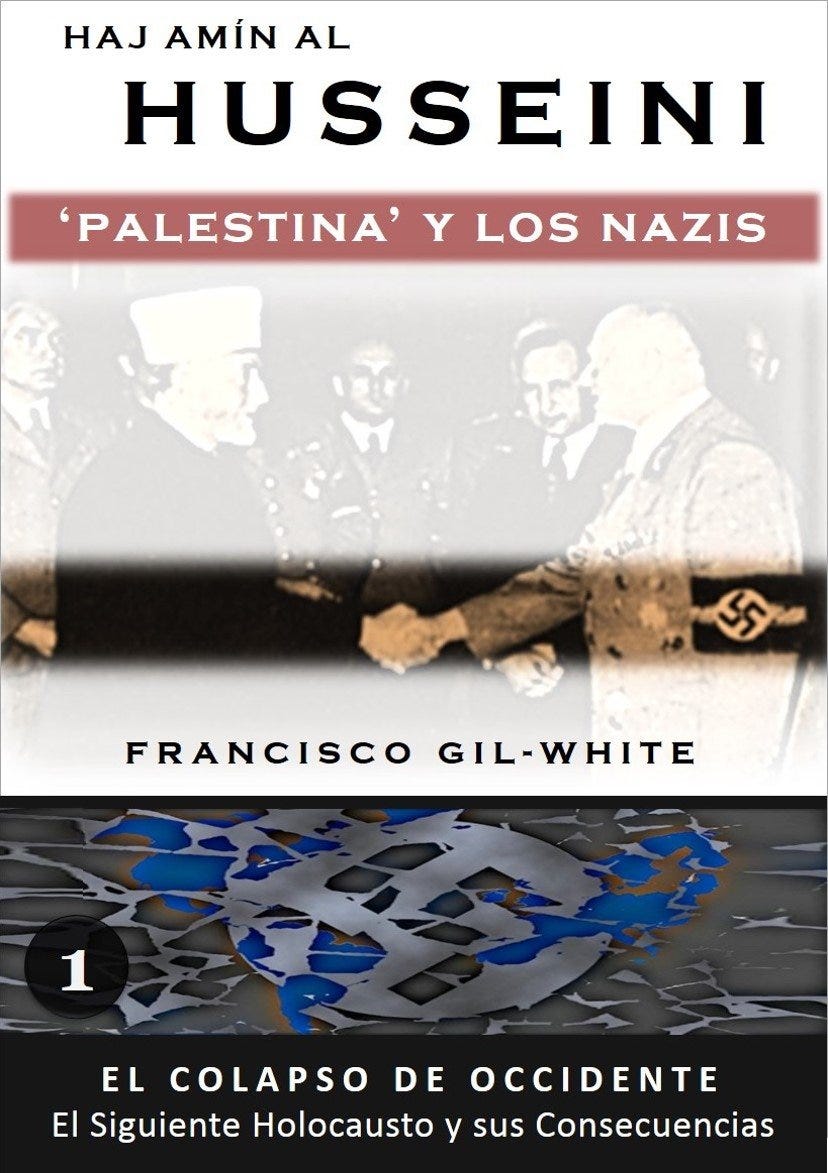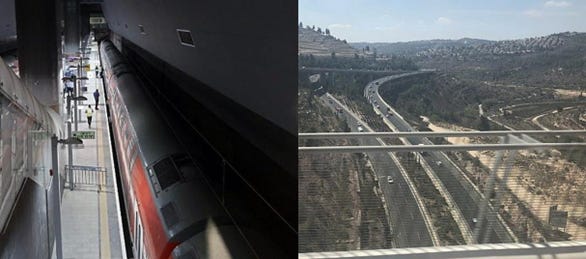And just what were we going to do in Israel?
A burly and bearded security man wanted to know. We were held up at a checkpoint of sorts prior to the immigration check. And yes: Who comes to Israel in the middle of the Hamas-Israel War? Tourism: dead. ’Twas a legitimate question.
“I was invited here by the ILAN Foundation.”
Burly man had an attitude—my wife and I looked suspicious. He needed to see a written invitation.
Oops…
Why couldn’t he ask for my marriage certificate instead? Yeah, like they had done at the security check before boarding our El Al flight in Madrid, incidentally flattering my wife with the implication that my relationship to her was implausible. I had redeemed myself then with an adroit Jedi flourish of my cellphone: le voilà. What a man. But now I was looking flatfooted: the wife had told me to get that invitation in writing from ILAN. Oh boy…
Burly man asked a few questions. Brusquely. Sternly. His attitude was: I may or may not believe your answers.
We had the answers. We didn’t stutter. And we never insulted his painfully broken Spanish by switching to English. But we were told to sit down with other incorrigibles there while he and colleagues did some opaque ‘security stuff’ and pondered the matter.
I texted Dov Litvinoff, CEO of ILAN, who was at the airport (his family was arriving in the same flight), and explained the situation to him. “I’ll talk to the guy,” he offered. Oh? That’ll probably work, I thought.
We had just finished descending Ben Gurion Airport’s giant ramp, decked with a long parade of photographs—so many!—of Israeli hostages wearing easy smiles from another time, before they understood they could be sucked from Daily Life and straight to Hell by sudden maelstroms of beyond-horror-film violence. The media world has forgotten these hostages—as if they never existed, as if they were not still captives—but not the Israelis. Every photo we saw had the caption: “BRING HIM/HER HOME NOW!”
Past all those hostages, whose families my heart silently joined but couldn’t comfort, we noticed on the wall, as the ramp was ending, a mural showcasing milestones and personages of Jewish history. That mural was clearly identified as a gift of the ILAN Foundation. And this security checkpoint that was holding us up was but five steps from that mural. Surely ILAN Foundation would ring a bell with these airport security people?

I took Dov’s call and began explaining the situation to him. Then burly man called for us to go show him our return tickets. He needed to see that we were planning to leave Israel.
I produced the tickets on my cellphone. As he was looking at them, Dov’s voice came through on the cellphone speaker. “It’s the CEO of ILAN,” I offered: “He can explain.” Burly man thrusted the phone back at me. “Hang up that phone. I won’t speak to him.”
Okay, we had return tickets, he confirmed. But he still needed to see that written invitation. I asked Dov to send it.
There was some more waiting while our documentation was examined and pondered, but this eventually worked. Burly man announced that we could stay until the 8th of January (our return flight was on the 7th). “But if you stay even one more day,” he said, “you’ll have a problem with me,” he emphasized, and he pointed to his chest. This performance obviously meant: I am a tremendously tough guy and you don’t wanna mess with me.
Yes, but the whole act was crumbling. Burly man was rapidly softening—even smiling a bit, despite himself. Soon the security lady he worked with gave us our passports. She seemed somewhat embarrassed by the show. “Enjoy your stay,” she smiled apologetically.
It is all psychologically very expert stuff, I am sure. The theater is functional, in case we are terrorists. A brusque and suspicious attitude can make some criminals trip and betray themselves. But we had never quite believed it: Hobbits trying to look mean, hoping they’ve twisted their faces into a right frown.
Ok, now you’ve caught me (I confess): I’m what they call a ‘Jew lover.’ Not a Jew, but definitely a ‘Jew lover.’ And I do something Jews call hasbara: I work hard to refute the lies daily spread in our media and academic spaces about Israel and the Jewish people. I tell you this because I think my readers should know where I stand (not that this has been any kind of secret).
It was my hasbara that had brought me to Israel in the middle of the Hamas-Israel War.
Much of my work in this area is ‘condensed’ into a (Spanish-only) ten-tome book series: El Colapso de Occidente: El Siguiente Holocausto y sus Consecuencias (The Collapse of the West: The Next Holocaust and its Consequences). The first five tomes came out in 2013 (I am working on the rest, promise). Over the last ten years, this series was charitably read by my students and not-so-charitably ignored by the rest of the planet.

I warned that the destruction of Israel was being systematically prepared by the Western power elites, in collaboration with the elites in the Muslim world. I often heard from those who learned of my claims that there was nothing to worry about because Israel was allegedly very strong. I replied that Israel could not guarantee the safety of the Israeli Jews. Lots of people came to think of me as a well-meaning (and probably harmless) paranoid case.
Now, after the Hamas attacks of October 7th, The Collapse began looking, at least to some, perhaps not quite so paranoid. In Mexico, Adela Micha, erstwhile co-anchor for what was once Mexico’s most-viewed TV news program (Jacobo Zabludovsky’s ‘24 Horas’), and now an important independent broadcaster, asked me over for an interview. I explained (some aspects of) my understanding of the historical and geopolitical context of the Hamas attacks. And I commented on the moral issues.
This went viral. I sold some books—finally. But the satisfaction was grim: I couldn’t help feeling anger that my warnings had not been heeded earlier. A good 1,200 people had just been murdered. And 250 had been taken hostage.
Isaac Assa, a Mexican Jew and the creator of ILAN, the Israel Latin American Network, saw the interview and invited me to lunch. Over some delicious Greek food, he explained how ILAN is focused on boosting Latin American innovation and technological development with Israeli assistance and know-how. It’s his way of combating antisemitism and defending the State of Israel: show the people of Latin America that Israel is a force for good. He was hoping we might do something together.
Soon after this I made a presentation to the Mexican Jewish community on the causes of Arab Muslim terrorism and the historical distortions on this topic regularly dished out by Western media and academia. Assa came. He liked what he saw. If I would come to Israel, he told me later, he would arrange for his people to give me a tour of the southern areas of Israel attacked on October 7th, and also of the communities in Shomron (Samaria)—part of what media and academia call ‘the West Bank’—that are now mostly deprived of men (all fighting at the front) and fearing for their lives lest Arab terrorists invade their communities too.
“Don’t bring your wife,” he cautioned. He himself was having trouble sleeping after visiting the destroyed communities in the south and learning more about the almost unimaginable atrocities committed there. I relayed this to the wife but she would brook no argument—she was coming. So now here we were, through the immigration check and legally in Israel to learn more about the atrocities and the ongoing war on the first day of 2024.
Happy New Year…
It was my third visit to Israel; my wife’s first. Her first material impression of the place was tremendous. Israeli infrastructure development is especially striking to Latinos (I’m Mexican; my wife, Colombian). Modern Latin American countries have been around for a while, much longer than Israel, and they are far, far richer in total territory and natural resources, but none have developed themselves anywhere near to what the Israelis have achieved in a handful of decades. Even Mexico, whose infrastructure is considerable relative to most other Latin American countries, and whose economy has long benefited from ‘near-shoring’ trade with the world’s biggest economy, cannot begin to compare.

“Just consider,” I said to her. “There was almost nothing here when the Zionist Jews began arriving in significant numbers in the late 19th century. As an independent country, Israel is not much older than me.” (I’m fifty-four.) “Most of this land was desert and swamp just a blink of an eye ago. And the people who built it arrived here with almost nothing.” We both pondered that as the comfortable high-speed rail whisked us from Ben Gurion Airport to Jerusalem, faster than the slowly receding cars also going our way on the perfect highways we saw from the train’s windows.
You know: what people call a ‘First-World’ country.
As we slowly made our way to the surface in the Jerusalem train station, we were shocked by just how deep the train had plunged beneath the Holy City, though we had been given a clue, as we were repeatedly forced to pop our ears during the dive. After exiting onto the street I texted my friends Isaac (different guy) and Richard, both also from Mexico. They were already in Jerusalem to participate with us in this research trip. Their prediction of 10 minutes’ time to collect us proved boastful; it was more like thirty. But those minutes weren’t wasted. My wife and I stood outside on the sidewalk with our suitcases, looking around like newborns, soaking in the atmosphere of Jerusalem at war.
She and I do the soaking a bit differently. We are both anthropologists, but Lu is a far keener observer than me. She almost immediately notices stuff that cries out for explanation—nothing escapes her. I am more the absent-minded-scientist type (I try to make up for that by reasoning hard about how different pieces of observational data might fit together theoretically). So, as we exited the train station and took our first steps in Jerusalem, it wasn’t me but Lu who caught the first anomaly.
“Have you noticed that several people in civilian clothing are walking about with machine guns hanging?”
“Oh…”
“Look: there goes one! And there: another.”
We tensed. But then almost immediately we relaxed. Designed by eons of evolution to quickly process vast amounts of contextual information with sophisticated pattern-recognition mechanisms feeding directly into our emotional systems (‘intuition’), our cognitive systems quickly got the gist of it: this was an anomaly to us but evidently not to the average Israeli walking the streets of Jerusalem.

Nobody seemed worried. The young men with guns were not wielding—much less pointing—their weapons, which hung limply from their shoulder straps. They didn’t seem to be doing anything special—not even patrolling. Just, whatever. One of them smiled and said hello to someone else as they walked by. Another casually entered a shop to buy something. They were just going about their day, it seemed. With machine guns hanging.
But, what was going on?
Gabriel Ben Tasgal, a Spanish-speaking Israeli who is a formidable presence in the Hispanic hasbara world, and a friend, later explained it to me. When Arab terrorist attacks against Jews proliferate in Israel, as happens every so dreadfully often, soldiers and reservists on active duty—but momentarily on leave—are asked to take their guns with them wherever they go. This is just in case a Jew is suddenly knifed or run down in the street by an Arab Palestinian terrorist, or if one such terrorist seems about to blow themselves—and those nearby—to pieces. (And you never know who might be an Arab Palestinian terrorist because they are careful to make themselves look like regular civilians.)
For example, the government of Israel instituted this policy in 2022, after a series of ramming and knifing attacks in Israeli cities (often against elderly Jews and/or women).
Here’s how one of those incidents went. An Arab Palestinian terrorist attacker “rammed and killed a cyclist with his car outside a gas station, before entering the station and stabbing a woman to death.” A jihadi ‘warrior.’ But he was not done. “The attacker returned to his car, drove to a nearby shopping center and stabbed three women, one of whom died.” That, however, was not yet enough. “The attacker then drove to a nearby roundabout, crashed into a second car, got out and stabbed to death a fourth civilian.”
Because they were Jews, you understand.

So how did nearby Jews with firearms react to this racist multiple murderer, to this monster on the rampage against Jewish persons? They tried to spare his life:
“Two armed passers-by tried to pacify the attacker before shooting him when he tried to stab one of them, according to video uploaded to social media on Tuesday evening. The attacker later died of his wounds, the police spokesman said.”
In the jihadi ideology preached within ‘radical’ (read: orthodox) Islam, this serial murderer is a shahid or ‘martyr.’ And—mind you—he was just one of three such knife-wielding, rampaging, rammers and stabbers of Jews “in less than a week.”
After October 7th, when 1,200 Jews were murdered, many tortured to death, and some 250 were taken hostage, some to be tortured, because they were Jews, the Israeli government once again turned ‘on’ the policy of having Israeli soldiers carry their machine guns at all times when on momentary leave. In this manner, with lots of armed Jews walking about, machine guns at the ready, ordinary Jews were feeling like they could come out and do the groceries in Jerusalem.
I felt safer, too.
But was this really needed? Oh yes. Just the other day, on January 15th,
“Hamas claimed responsibility for the combined ramming and stabbing attacks in Ra’anana on Monday afternoon, which left over a dozen people wounded and one person dead.”
Our first sociological impression of Israel, then, was this: for all their material development, the Israeli Jews are not safe in their own country. Hell, the Jews—supposedly ‘too powerful’ according to the loud antisemites, who claim they supposedly control everything—are getting bullied by antisemites even in their holy capital city.
Of course, the insecurity of Jews in the Jewish State had already been amply demonstrated on October 7th. But as happens always in anthropology, the encounter with the street—here, the Jewish street—really brought the point home for us.
And to think this is reality in a country that, following the worst anti-Jewish genocide, was explicitly and loudly built—or so they promised—to make life safe for Jews!
ISRAEL TRIP (Part 2). Identity, worldview, the civilian, and the soldier
“When he died, he died on the [Gaza] border, protecting the civilians behind him (…) In Jewish belief, when you die for your country, for your nation, this is the best death. I think the best way is to go on with living and making good things for others. But we have to fight in Israel for our existence, for our survival. And it’s very difficult, in a personal way. No matter what they say about how important it [my son’s sacrifice] was, the personal grief is very, very deep.”








You are such a brilliant writer and a force for good in the world! Thank you 🙏❤️ I’m so glad I discovered you.
Welcome to Israel Francisco!
Like yourself, in 2016 my spouse and I produced a music video "documentary" about Israel (in SPANISH) for a contest sponsored by the Israel Video Network.
The video came out fabulous - but not fab enough for the IVN!
Since then, it's been sitting on You Tube waiting for the right time and audience.
Would you mind sharing the link with the organizers of your convention? It is exactly the type of positive hasbara they are looking for.
Thank you and God bless!
"Israel- Child of Hope and Home of the Brave"
https://youtu.be/z_hrQf5E1GI?si=qjanLL8wg5cUpD2J